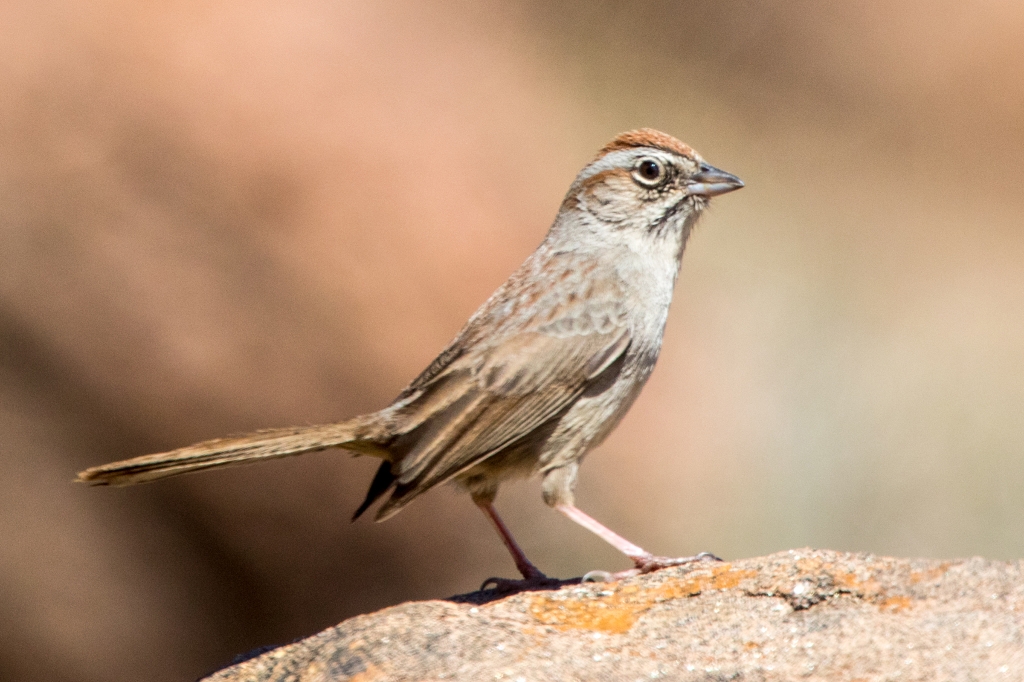
Scientific Name
Aimophila ruficeps obscura
Introduction
The rufous-crowned sparrow is a small American sparrow that is found mostly across South-western USA and Mexico. An endemic subspecies of the rufous-crowned sparrow, r. obscura, first described in 1923 by Donald Dickey and Adriaan van Rossem, resides in the national park on Anacapa and Santa Cruz islands.This endemic subspecies was formerly found on
Quick and Cool Facts
- Rufous-crowned sparrow pairs remain on their territories year-round and stay bonded for life.
- The rufous- crowned sparrow was first described in 1872 from specimens taken in Arizona. From 1886 to 1915 it was not recorded in the state.
- This secretive little bird spends most of its time on the ground, but if startled it will investigate by flying to a nearby perch. An exception is during spring mornings when this bird sings from the tops of boulders or another similar perch.
- This sparrow is awkward in flight and primarily uses running and hopping to move.
- Nesting sparrows have been observed using three kinds of displays to distract potential predators for their nest;the rodent run, the broken wing, and the tumbling off the bush.
- They have been known to live for up to three years, two months.
Appearance
This sparrow has a chestnut-brown rufous crown, brown back with dark streaks, brown wings and a long, brown tail. It has a pale gray face, back of neck, chest, belly, and underparts. It also can be identified by its brown, rufous eyestripe and conical black bill. Another key identifier is its conspicuous black "whisker" mark on side of its chin. The sparrow also has pink legs and feet. The sparrow's young have diffuse streaks on their breast and flanks. Both sexes of the rufous-crowned sparrow are similar in appearance and their size ranges from 5 to 6 inches in length.The endemic subspecies, r obscura, is darker in color, has a heavier bill, longer tarsi, and heavier toes.
Range
This subspecies of rufous-crowned sparrow is found year-round on Santa Cruz island and West and Middle Anacapa. While this bird does not nest on East Anacapa, it can occasionally be seen there (Collins 2008).
Habitat
Habitats favored by the rufous-crowned sparrow on the islands are coastal-bluff, coastal sage and open coyote-brush scrub, often rocky in nature and located in steep ravines and canyons. These birds are both ground nesters and ground feeders. On Santa Cruz, the sparrow’s prime habitat includes grassy hill slopes and canyon walls with scattered bushes or clumps of cactus.
Feeding
These sparrows forage primarily on the ground, generally under the protective cover of vegetation, and only rarely in open areas, in foli¬age, or on branches of taller woody vegetation. The fall diet of rufous-crowned sparrows in California is 88.4% vegetables, which are primarily small grass and forb seeds, fresh grass stems and tender plant shoots. The rest of its diet, amounting to 11.6%, is animal matter of which insects such as ants, grasshoppers, ground beetles, and scale insects make up that small percentage for the fall and winter diet.Animal matter is generally taken in higher proportion during the breeding season.
It is unknown whether this species obtains adequate water from its diet or if dietary water must be supplemented by drinking. Individuals have been observed drinking from and bathing in pools of water in rock crevices following rainstorms.
Reproduction
There are no data on the characteristics of nest placement by island sparrows, but they probably select settings similar to those used byA. ruficepson the main land. Their nests generally are in grass or against shrubs or grass tussocks either on or flush with the ground in a natural depression or hole in the ground or, infrequently, up toa foot and a half off the ground in a low bush. Pairs will raise two and possibly three broods and will ren est following nest failure. Breeding occurs from late March to late August.
Conservation Status
Rufous-crowned sparrow habitat on the islands was adversely affected by the heavy grazing that occurred on Anacapa and Santa Cruz Islands, and birds were likely more vulnerable to native and non-native predators such as island scrub-jays, foxes, and spotted skunks. However, recent work suggests that the species has benefited from the removal of sheep and other grazers, and may be increasing in both distribution and abundance.
According to the IUCN Red List status of Globally Threatened Birds, this species has an extremely large range, and hence does not approach the thresholds for Vulnerable under the range size criterion. Despite the fact that the population trend appears to be decreasing, the decline is not believed to be sufficiently rapid to approach the thresholds for Vulnerable under the population trend criterion. The population size is extremely large, and hence does not approach the thresholds for Vulnerable under the population size. For these reasons the species is evaluated as Least Concern.
Additional Information
- https://nrm.dfg.ca.gov/FileHandler.ashx?DocumentVersionID=19951
- http://www.allaboutbirds.org/guide/rufous-winged_sparrow/lifehistory
- http://www.prbo.org/calpif/htmldocs/scrub.html
- http://www.bird-friends.com/BirdPage.php?name=Rufous-Crowned%20Sparrow
- http://www.birdlife.org/datazone/speciesfactsheet.php?id=9023
- http://www.avianweb.com/rufouscrownedsparrows.html
Is there something we missed for this itinerary?
Itineraries across USA


















































